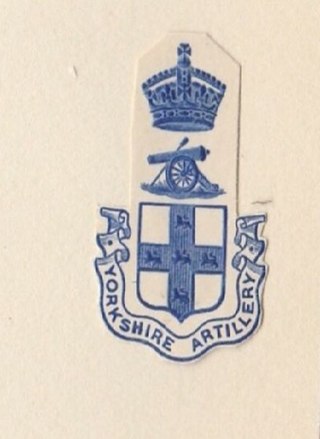The Forfar and Kincardine Artillery was a British artillery militia regiment of the 19th century. It was based in and named after Forfarshire and Kincardineshire in Scotland.
The East Suffolk Militia was one of two regiments of militia raised in Suffolk. Formed in 1759 it was converted in 1853 to an Artillery Militia unit, which was eventually disbanded in 1909.
The Durham Artillery Militia was a part-time reserve unit of Britain's Royal Artillery based in County Durham from 1853 to 1909. Volunteers from the unit served in the Second Boer War where they distinguished themselves fighting as infantry in the defence of Fort Prospect.

The Yorkshire Artillery Militia was a part-time reserve unit of Britain's Royal Artillery based in the East and North Ridings of Yorkshire from 1860 to 1909.
The Duke of Edinburgh's Own Edinburgh Artillery was a part-time reserve unit of Britain's Royal Artillery based in the City of Edinburgh from 1853 to 1909. Volunteers from the unit served in the Second Boer War.
The Royal Lancashire Militia Artillery was a part-time reserve unit of Britain's Royal Artillery based in Lancashire from 1853 to 1909.
The Antrim Artillery was a part-time reserve unit of Britain's Royal Artillery based in County Antrim, Northern Ireland, from 1853 to 1919. It numbered 1st on the order of precedence of the Militia Artillery. Volunteers from the unit served in the Second Boer War. During World War I it defended Belfast Lough and trained gunners for service overseas. Subsequent units continued the Antrim Artillery traditions.
The Mid-Ulster Artillery Militia was a part-time reserve unit of Britain's Royal Artillery based in Northern Ireland. Formed from three smaller units in 1875, it served until 1909.
The Dublin City Artillery Militia was a part-time reserve unit of Britain's Royal Artillery based in Dublin, Ireland, from 1854 to 1909.
The Kent Militia Artillery was a part-time reserve unit of Britain's Royal Artillery based at Dover in Kent, from 1853 to 1909.
The Galway Militia Artillery was a part-time reserve unit of Britain's Royal Artillery based in County Galway, Ireland, from 1854 to 1888.
The Royal Glamorgan Artillery Militia (RGAM) was a part-time reserve unit of Britain's Royal Artillery based at Swansea in Glamorgan, South Wales, from 1854 to 1909.
The Northumberland Militia Artillery was a part-time reserve unit of Britain's Royal Artillery based in the County of Northumberland, from 1854 to 1909.
The Royal Sussex Militia Artillery was a part-time reserve unit of Britain's Royal Artillery from the County of Sussex, which served from 1853 to 1909.
The Donegal Artillery was a British Militia Artillery regiment of the 19th century. It was based in and named after County Donegal in the modern Republic of Ireland.
The Argyll & Bute Militia was a part-time military unit in the west of Scotland from 1798 to 1909, serving in Home Defence during the French Revolutionary War, Napoleonic Wars and Second Boer War. Originally an infantry regiment, it was converted into artillery in 1861.
The Clare Militia was a British militia regiment from 1798 to 1909. It was based in County Clare. At first an infantry unit, it was converted to artillery in 1882, making it the last artillery militia unit raised in the British forces. It was disbanded in 1909.

The Militia Artillery units of the United Kingdom and Colonies were military reserve units made up of volunteers who served part-time during peacetime, training to take over responsibility for manning fixed artillery batteries from the regular Royal Artillery during times of war.

The Cinque Ports Division, Royal Artillery was an administrative grouping of garrison units of the Royal Artillery, Artillery Militia and Artillery Volunteers within the British Army's South Eastern District from 1882 to 1889.
The Fifeshire Militia was an auxiliary regiment raised in Fifeshire, Scotland, in 1798. It served in home defence during the Napoleonic Wars and again during the Crimean War when it was converted into an artillery unit as the Fifeshire Artillery Militia. It served in home defence again during the Indian Mutiny and the Second Boer War. It was disbanded in 1909.


